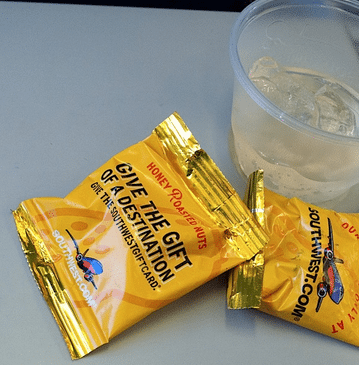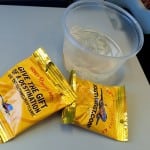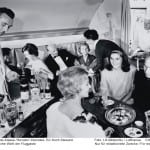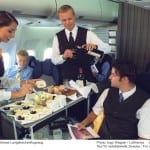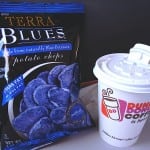Skift Take
When it comes to serving food on board, airlines can't seem to win: whatever they serve is criticized for its quality, but if they cut back, they hear about that, too. The life of the airline peanut - after decades, barely hanging on to its role as the prototypical on-board snack - is representative of airline food's career, both triumphs and struggles.
- The sack of peanuts that made peanuts worth much more than peanuts, thanks to Southwest.
- Introduction of the first class “Senator” service. En chef steward made for the pleasure of his passengers (1958).
- Boeing 707 first class cabin of Lufthansa (around 1975).
- Business Class on Lufthansa long-haul Airbus A340, 1998
- JetBlue’s custom Terra Blue chips.
When peanuts first became a well-known airline staple, it was all because Southwest Airlines was trying to spin a negative.
To offer the cheapest flights on the market, the budget carrier had eliminated on-board meals. But it wanted to make sure consumers saw the connection between its minimal service and low fares. So Southwest marketed itself as the “peanut airline” – meaning you fly for ‘peanuts,’ and peanuts are what you get.
“It was all about marketing,” said Bob Van der Linden, chair of the aeronautics division at the Smithsonian National Air and Space Museum. Other airlines served peanuts before and have since, Van der Linden said, but “Southwest was the first to serve only peanuts, and did so proudly, to show how cost efficient it was.
With little variation, both Southwest and its peers continued to serve free peanuts and other snacks for the next three decades, even as much else came and went.
That changed in the post-9/11 world of air travel’s free-fall. Where once free snacks had been a staple of even the cheapest carrier, airlines started to see them as an underappreciated perk not worth their cost. And airlines feel that cost not only in the purchase price of the peanuts themselves, but also the extra time it takes to load, unload, and distribute them on board.
In a market where turnaround is measured in minutes, that adds up. Delta once calculated that by removing a single strawberry from the salads it served in first class, it would save $210,000 a year, and that a one-cent increase in peanut prices would increase its costs by $610,000 a year.
So by 2011, many airlines’ free snacks had gone the way of other ancillary services: eliminated in order to save costs. By March of 2011, Continental, United, American and US Airways had eliminated peanuts and other free snacks from their flights, saving an estimated $2.5 million per year.
They still stock food on board, but now charge for it – dearly. The mini packages of peanuts, which cost airlines about 7 cents each when they buy in bulk, go for around $3.
Peanuts Face Food Phobia
But peanuts in particular faced another obstacle in recent years, as allergy mania swept the country. Possibly encouraged by airlines’ willingness to abandon peanuts after a national salmonella outbreak in 2009, anti-peanut activists seemed to push harder than ever for their removal from all flights.
In response to several complaints and a lawsuit or two, some airlines did stop stocking peanuts, and in 2010 the Department of Transportation even considered an industry-wide ban on the deadly legumes. The ban didn’t sprout legs, because the DOT found that a prior law required it conduct a peer-reviewed study before passing such a rule. Still, several airlines, including Continental, United, US Airways JetBlue, and American Airlines, voluntarily stopped serving packaged peanuts, in order to avoid further complaints.
You can still find peanuts on Delta flights, and of course on Southwest, which handed out 88.3 million bags of peanuts to passengers in 2012. But while the airline peanut survived the dual threats of cutbacks and allergies, it has now taken on the bitter taste of an overbilled perk bound to disappoint.
Airline Food Through The Ages
Eating on board wasn’t always this pitiful. Once upon a time, airline meals were something to drool at. Because the industry was strictly regulated, prices were even across the board, so the only way for companies to compete was to offer a better on-board experience than their rivals. Food was a prime way to do that. (Free airline-branded cigarettes were also a big draw from the 1930s to the 1950s, according to history Professor Guillaume de Syon.)
“There was a time when even in coach class you always got a hot meal,” said Bob Van der Linden. Airlines have been serving food on board since the 1930s, first cold sandwiches and then, by the mid-1930s, proper multicourse hot meals. And they were good meals. Things like lamb chops, roast beef and potatoes, champagne and caviar. “The irony,” said Van der Linden, “is that everyone complained about them.”
At one point, airlines even moved their dining operations to the ground, in an effort to improve their quality. “By the late ‘30s and early ‘40s, some American airlines came up with the alternative to let the passengers out to eat when you land at a technical stop,” which planes had to do often back then, said Professor de Syon.
“You feed them at the airport restaurant, give them alcohol, cigarettes and make them feel better,” after an inevitably bumpy ride, he said. All this for the price of the fare – which was, admittedly, comparatively much higher back then.
It was only when air travel became too popular for airport restaurants to handle the masses that airplanes began developing their own catering arms – or contracting to outside companies.
“You need to feed more people, so you star to get more standardized meals,” said Professor de Syon. “You start to see the separation between incredible meals in first class and what most of us get to sample in steerage.”
That’s when they first started to measure the price of an extra olive or tomato, and how much money they could save by cutting back on the garnishes no one was eating anyway. “They started to get much more careful about this stuff starting in the 1970s, and much more after September 11th,” said Professor de Syon.
Of course, as much as Jet Age passengers lamented imperfect on-board meals – complaining about lukewarm soup or caviar – today they complain about the lack of complimentary food options.
“What all of the airlines have discovered is that their customers will complain, but when given the choice between an amenity and a cheap ticket, they’ll take the cheap ticket every time,” said Bob Van der Linden. “And then complain.”
The Daily Newsletter
Our daily coverage of the global travel industry. Written by editors and analysts from across Skift’s brands.
Have a confidential tip for Skift? Get in touch
Tags: food and drink, in-flight
Photo credit: Southwest serves complimentary peanuts on each flight. Justin Taylor / Flickr
